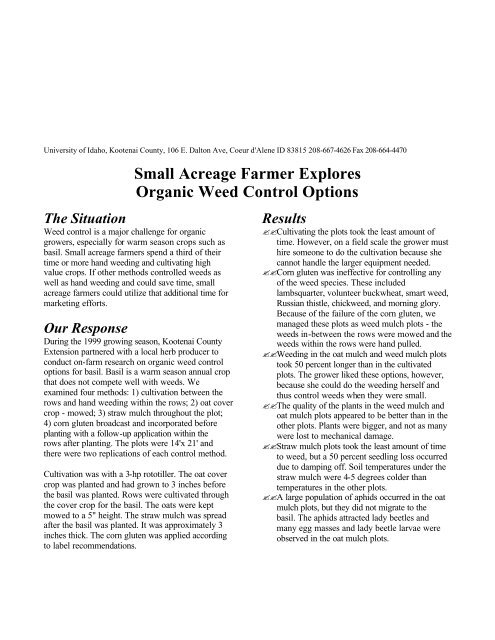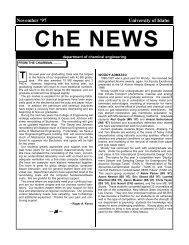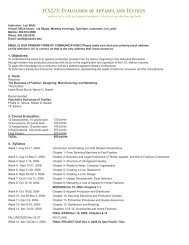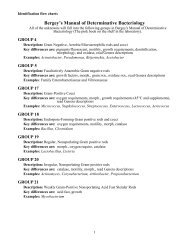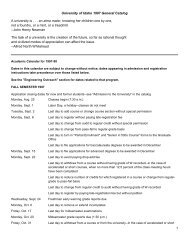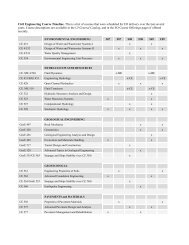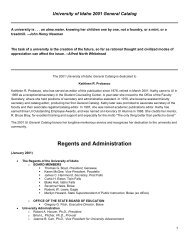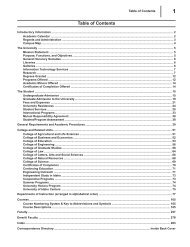Small Acreage Farmer Explores Organic Weed Control Options
Small Acreage Farmer Explores Organic Weed Control Options
Small Acreage Farmer Explores Organic Weed Control Options
You also want an ePaper? Increase the reach of your titles
YUMPU automatically turns print PDFs into web optimized ePapers that Google loves.
University of Idaho, Kootenai County, 106 E. Dalton Ave, Coeur d'Alene ID 83815 208-667-4626 Fax 208-664-4470<br />
<strong>Small</strong> <strong>Acreage</strong> <strong>Farmer</strong> <strong>Explores</strong><br />
<strong>Organic</strong> <strong>Weed</strong> <strong>Control</strong> <strong>Options</strong><br />
The Situation<br />
<strong>Weed</strong> control is a major challenge for organic<br />
growers, especially for warm season crops such as<br />
basil. <strong>Small</strong> acreage farmers spend a third of their<br />
time or more hand weeding and cultivating high<br />
value crops. If other methods controlled weeds as<br />
well as hand weeding and could save time, small<br />
acreage farmers could utilize that additional time for<br />
marketing efforts.<br />
Our Response<br />
During the 1999 growing season, Kootenai County<br />
Extension partnered with a local herb producer to<br />
conduct on-farm research on organic weed control<br />
options for basil. Basil is a warm season annual crop<br />
that does not compete well with weeds. We<br />
examined four methods: 1) cultivation between the<br />
rows and hand weeding within the rows; 2) oat cover<br />
crop - mowed; 3) straw mulch throughout the plot;<br />
4) corn gluten broadcast and incorporated before<br />
planting with a follow-up application within the<br />
rows after planting. The plots were 14'x 21' and<br />
there were two replications of each control method.<br />
Cultivation was with a 3-hp rototiller. The oat cover<br />
crop was planted and had grown to 3 inches before<br />
the basil was planted. Rows were cultivated through<br />
the cover crop for the basil. The oats were kept<br />
mowed to a 5" height. The straw mulch was spread<br />
after the basil was planted. It was approximately 3<br />
inches thick. The corn gluten was applied according<br />
to label recommendations.<br />
Results<br />
??Cultivating the plots took the least amount of<br />
time. However, on a field scale the grower must<br />
hire someone to do the cultivation because she<br />
cannot handle the larger equipment needed.<br />
??Corn gluten was ineffective for controlling any<br />
of the weed species. These included<br />
lambsquarter, volunteer buckwheat, smart weed,<br />
Russian thistle, chickweed, and morning glory.<br />
Because of the failure of the corn gluten, we<br />
managed these plots as weed mulch plots - the<br />
weeds in-between the rows were mowed and the<br />
weeds within the rows were hand pulled.<br />
??<strong>Weed</strong>ing in the oat mulch and weed mulch plots<br />
took 50 percent longer than in the cultivated<br />
plots. The grower liked these options, however,<br />
because she could do the weeding herself and<br />
thus control weeds when they were small.<br />
??The quality of the plants in the weed mulch and<br />
oat mulch plots appeared to be better than in the<br />
other plots. Plants were bigger, and not as many<br />
were lost to mechanical damage.<br />
??Straw mulch plots took the least amount of time<br />
to weed, but a 50 percent seedling loss occurred<br />
due to damping off. Soil temperatures under the<br />
straw mulch were 4-5 degrees colder than<br />
temperatures in the other plots.<br />
??A large population of aphids occurred in the oat<br />
mulch plots, but they did not migrate to the<br />
basil. The aphids attracted lady beetles and<br />
many egg masses and lady beetle larvae were<br />
observed in the oat mulch plots.
??The 1999 season was unseasonably cold with<br />
frosts occurring in late June and early<br />
September. The basil was planted more than 2<br />
weeks later than normal and was severely<br />
damaged by the September frost, so we were<br />
unable to evaluate yields.<br />
The Future<br />
??The grower is going to incorporate the weed<br />
mulch and oat mulch methods into her farm<br />
plan.<br />
??Our 1999 results will be distributed to other<br />
small acreage farmers through the Rural Roots<br />
newsletter and website, and through the North<br />
East Washington/Northern Idaho (NEWNI)<br />
Extension <strong>Small</strong> Farm Team newsletter.<br />
??In 2000 we will examine other living mulches as<br />
options for organic weed control.<br />
For More Information<br />
Vickie Parker-Clark, Ph.D.<br />
Extension Educator, <strong>Small</strong> Farms/Crops/Hort.<br />
Kootenai County Cooperative Extension System<br />
University of Idaho<br />
106 E. Dalton Ave.<br />
Coeur d'Alene ID 83815<br />
Phone: 208-667-6426<br />
Fax: 208-664-4470<br />
E-mail: vickiepc@uidaho.edu<br />
C:\My Documents\IMPACT \Impacts-1999\<strong>Organic</strong> <strong>Weed</strong> <strong>Control</strong>.doc<br />
12/ 999


